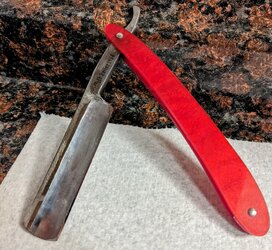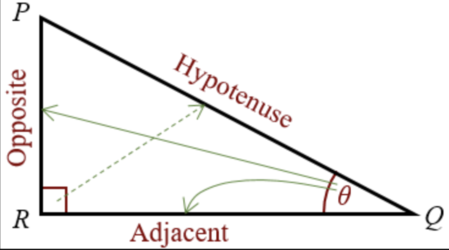A few weeks ago, I was exchanging messages on Badger & Blade about my challenges obtaining a decent edge and good shave on a large 11/8ths razor. It was mentioned to me that the angle is likely an issue due to it's size.
I am hoping that amongst the B&B audience there is a mathematician or trigonometrist (sp?) who can tell me if the following is correct. The non-mathematicians can tell me if it's helpful in any way at all.
My thinking is there has got to be a straight forward formula for bevel angle using the ratio of a blade's face size and spine width. This would enable the quick determination of a razors angle as well as the impact of honing with tape.
If a picture tells a thousand words, here is my attempt at a picture:

So I relied on Google a bit, watched a tutorial on trigonometry and the use of inverse sine and applied it to a few of my favorite razors (see below):

Keep in mind that the blade size in the titles are the full blade size but in the table it is the measure from shaving edge to the side of the bevel that would touch the stone when honing.
If this is correct (and please let me know if it isn't) I have three realizations:
First, that there is a huge variation in blade bevel angles. I thought American blades would be narrower but they aren't, they were just smaller. However, I did find some of my older Sheffield razors to be close to 20 degrees, so their comfort isn't simply the difference between wedge vs. hollow ground.
Second, I realized that regardless of whether a razor is 15 degrees or 20, they still shave great if they have a well set edge.
Third, within this range of angle, taping doesn't change it much. Add to this that my measure of taped spines doesn't considered compression and wear during honing. I suspect the impact is half of what the table shows.
I hope that no one has ever been removed from B&B for presenting faulty math.
I am hoping that amongst the B&B audience there is a mathematician or trigonometrist (sp?) who can tell me if the following is correct. The non-mathematicians can tell me if it's helpful in any way at all.
My thinking is there has got to be a straight forward formula for bevel angle using the ratio of a blade's face size and spine width. This would enable the quick determination of a razors angle as well as the impact of honing with tape.
If a picture tells a thousand words, here is my attempt at a picture:
So I relied on Google a bit, watched a tutorial on trigonometry and the use of inverse sine and applied it to a few of my favorite razors (see below):
Keep in mind that the blade size in the titles are the full blade size but in the table it is the measure from shaving edge to the side of the bevel that would touch the stone when honing.
If this is correct (and please let me know if it isn't) I have three realizations:
First, that there is a huge variation in blade bevel angles. I thought American blades would be narrower but they aren't, they were just smaller. However, I did find some of my older Sheffield razors to be close to 20 degrees, so their comfort isn't simply the difference between wedge vs. hollow ground.
Second, I realized that regardless of whether a razor is 15 degrees or 20, they still shave great if they have a well set edge.
Third, within this range of angle, taping doesn't change it much. Add to this that my measure of taped spines doesn't considered compression and wear during honing. I suspect the impact is half of what the table shows.
I hope that no one has ever been removed from B&B for presenting faulty math.



